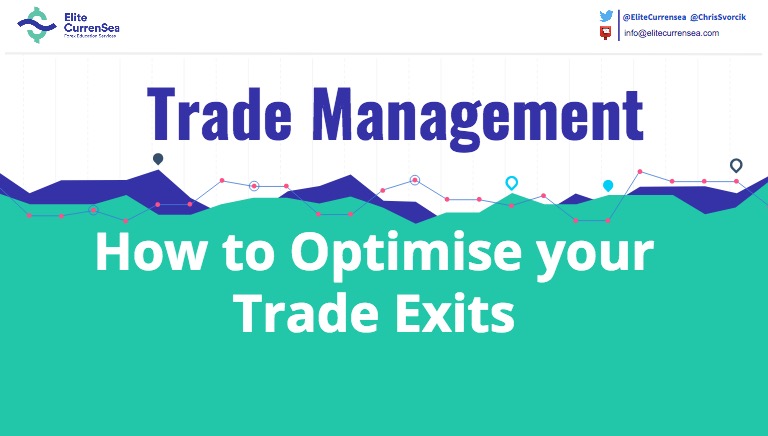Trade Exits – Finding a Way that Works

Dear Traders,
we traders focus a lot of attention on finding the right entry level… so much so that the skill of choosing trade exits/targets is often neglected.
This article will discuss the art of trade exits and the pros and cons of different approaches.
One Size Does Not Fit All
Different trading styles require a different approach to exits/targets. I have found that I can only ever set my target as far as my chart analysis goes, i.e. if you trade on a smaller time frame and enter a setup without looking at the larger picture too much, you have to accept that your target needs stay within the scale of the swings that apply to your analysed time frames. Hoping for bigger targets without putting in the effort to analyse the broader market structure in great detail will often end up in sub-optimal results.
So finding optimum exits/targets depends very much on the depth of your pre-trade analysis, and on your trading style.
Which is better… Big Targets or Small Targets?
One question that arises when considering targets is whether setups with big targets are better than trades with smaller ones.
A key consideration in this regard is of course the Reward-to-Risk ratio, which I have discussed in a previous article in more detail (might be a good idea to read it if you haven’t already). So for today, it will suffice to say that big targets are only truly big if the reward-to-risk ratio is high. There is no extra benefit in a trade with a 500 pip target that requires a 250 pip stop loss, compared to a trade, which aims for a 50 pip target but only requires a 25 pip stop loss. The large trade will simply take longer to complete for the same amount of reward (if you follow sound risk management protocols).
There are however also other factors to consider beyond the reward-to-risk ratio.
New Setup = New Risk
Trade setups with large targets (i.e. based on medium or long-term price swings) have one significant advantage in my opinion… namely that they offer the opportunity to add more positions (scaling-in) to the same setup as price progresses towards the intended target, something that trades on smaller time frames do not really offer.
The main advantage I see with bigger trade setups is that you are dealing with one and the same setup instead of new ones all the time. With every new setup comes a new risk situation and uncertainty. You have to expose your capital to brand new circumstances if you trade many setups with smaller targets on smaller timeframes.
Conversely, a longer-term setup with a target that is far enough away to enable scale-ins, has the benefit of being one and the same situation throughout the entire time. By the time you scale-in, your initial position will be in profit already and you have the added advantage of seeing all the price-action information that has happened since your first entry, which is very useful for validating that price is behaving according to your analysis, and for making scale-in decisions.
These advantages do not exist when you enter brand new setups. You always start out from the point of the unknown again. This is why I, personally, am migrating more and more towards medium to long term trades.
To Trail or Not to Trail… That is the Question!
Another challenge of trade exits comes when we have to consider whether to trail-stop a position or whether to aim for a fixed target. Both come with their pros and cons:
Trail-Stop Pros:
- It means that one has at least some profits secured, even if they are not much yet.
- Can take out the emotional stress while having open positions.
Trail-Stop Cons:
- Trail stopping inevitably means that the trade will close at a sub-optimum price levels because it will close during a pullback as opposed to a peak.
- It is easy to fall into the fear of losing profits when trail-stopping, and it can be tempting to bring the stop so close to the live price level that it will stop out even more prematurely.
Fixed Target Pros:
- The intended reward-to risk ratio of ones original setup analysis will be fulfilled at the target level. This can be very important for growing your equity curve successfully.
- If the target is analyzed well, it can mean that the trade is exited at as close to optimum levels as possible, maximizing the gain of the setup.
Fixed Target Cons:
- The danger exists that targets are missed and that all floating profits disappear again after having come relatively close to the target.
- It requires more psychological strength to endure potential ups and down during the open trade. If one doesn’t have it, it can lead to ‘panic exits’ at profit low-points.
Some people choose a combination of these two approaches, by trying to gauge the when price is at an interim peak and closing the position at that point, and then re-enter the trade at the peak of the next pullback. This can be a good and effective trade management approach but it requires more intense monitoring (especially if done on smaller time frames) and the skill/experience to know when interim swing highs and lows are culminating.
Conclusion
Trade exiting is a skill in its own right and deserve as much attention as stop loss settings and trade entries. Exits can make all the difference between making small or big amounts of money and have a significant impact on ones overall equity growth.
Find a system with which you are comfortable and perhaps test out several target/exit approaches (on a demo account or on paper) in order to gather experience of what works better for your style of trading.
All the best along your trading journey
Hubert
.







Leave a Reply